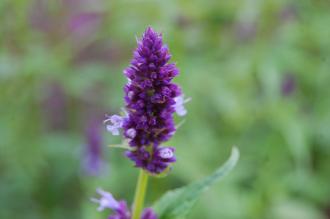
Agastache ‘Black Adder’ (02/07/2016, Kew Gardens, London)
Position: Full sun
Flowering period: Summer to early autumn
Soil: Moist, well drained
Eventual Height: 75cm
Eventual Spread: 50cm
Hardiness: 6b, 7a, 7b, 8a, 8b, 9a, 9b
Family: Lamiaceae
Agastache ‘Black Adder’ is deciduous herbaceous perennial with a clump forming upright habit. Its mid green leaves are ovate to lanceolate with serrate margins, up to 10cm long and 4cm wide. Its leaves are fragrant when crushed. Its dark purple flowers are tubular with two lips, appear as terminal spikes and are up to 20cm long. Its flower spikes will remain on the plant during the winter months.

Agastache ‘Black Adder’ Flower (02/07/2016, Kew Gardens, London)
Agastache ‘Black Adder’, commonly known as Giant Hyssop ‘Blackadder’, is a cross between Agastache rugosum and Agastache foeniculum.
The etymological root of the binomial name Agastache from the Greek agan meaning ‘very much’ and stachys meaning ‘spike’.
The landscape architect may find Agastache ‘Black Adder’ useful as part of a mixed herbaceous planting scheme.

Agastache ‘Black Adder’ Leaf (02/07/2016, Kew Gardens, London)
Ecologically, Agastache ‘Black Adder’ flowers are attractive to pollinating insects, including butterflies.
Agastache ‘Black Adder’ prefers moist, fertile, well-drained soils. It tolerates most pH of soil. It dislikes wet soils. It will tolerate poor soils.
Agastache ‘Black Adder’ requires little maintenance. To keep a tidy, compact appearance this plant may be cut to near ground level in spring.

Landscape Architecture

